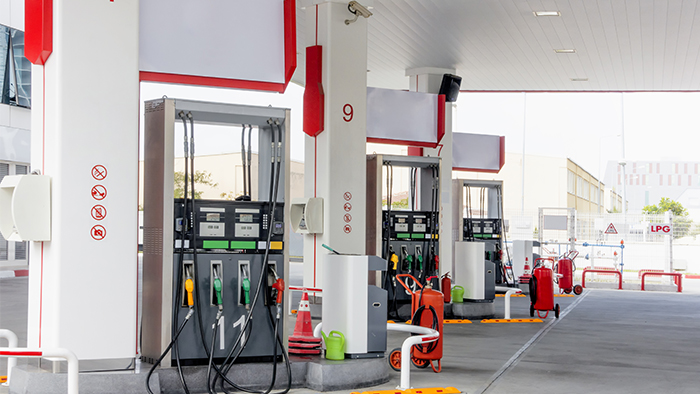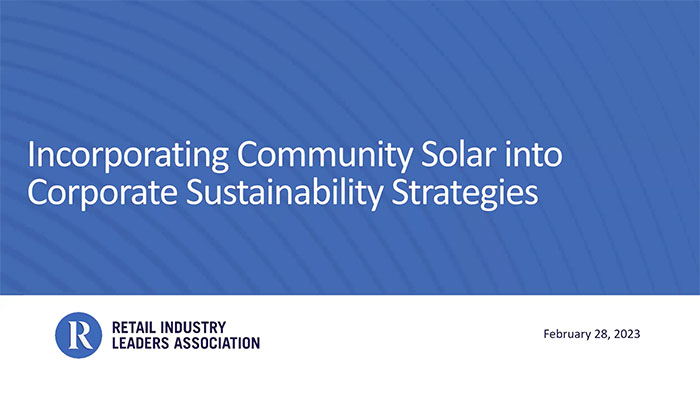Air Regulations
In retail, air regulations typically cover air emissions from stationary (for example, generators and refrigerant systems) and mobile (trucks and vehicle fleets) sources. Potential causes of air pollution in a retail setting include operation of emergency generators, refrigerants, vehicles, building renovations involving asbestos, and gasoline storage, handling and dispensing. Specialty retail activities such as automotive repair can also be a source of air pollution. Odors and noise, which are regulated at state and local levels, are included in this category. This page does not cover potential air emissions from products – which are covered on the Product Compliance and Toxins Regulations page.
Compliance Considerations
Air quality is regulated at federal, state and local levels. Few if any retail facilities will be large enough to require a federal air permit. Most retail facilities will be regulated at the state or even local levels. State air permits are often required for facilities with large boilers, emergency generators, during construction, or that have specific operations such as paint spray booths. The types of businesses likely to need a state or local air permit include auto body shops, dry cleaners, and gas stations.
To determine if your facility needs an air permit, you must check with state and local agencies.
Want to know more about air regulations?
The federal Clean Air Act (CAA) is designed to protect air quality and regulates emissions from stationary and mobile sources. Under the CAA, EPA set air quality standards for six common pollutants, which are called criteria pollutants: ground-level ozone, particulate matter, sulfur dioxide (SO2), nitrogen oxides (NOx), carbon monoxide (CO), and lead. EPA identifies areas with air quality that does not meet standards for healthy air, which are called "nonattainment areas" (in other words, these areas, usually urban, do not attain acceptable air quality for one or more of the criteria pollutants). States develop plans for how to meet the air quality standards, called State Implementation Plans or SIPs. This means that states can have unique requirements and procedures, and requirements may differ for facilities in nonattainment areas.
EPA also regulates the emission of hazardous air pollutants (HAP). Examples of HAPs include benzene, which is found in gasoline; perchloroethylene, which is used in dry cleaning; and methylene chloride, which is used as a solvent and in paint strippers for commercial use.
As federal air quality permits are based on the amount of actual or potential air pollutant emissions, few if any retail operations will be considered a major source of air pollution. Smaller sources, such as gas stations and dry cleaners, may be considered area sources, however. For more information, EPA has a Plain English Guide to the CAA.
Refrigeration, Air Conditioning & Refrigerated Transportation
Refrigeration, Air Conditioning and Refrigerated Transportation use refrigerants that may contain Class I ozone-depleting substances (ODSs), such as chlorofluorocarbons (CFCs) or Class II ODSs, hydrochlorofluorocarbons (HCFCs). Class I substances, including CFCs, have been phased out in the United States, with a few exceptions. New production and import of most HCFCs were phased out as of 2020. In 2016, EPA revised the refrigerant regulations to limit the impact of ODSs and certain refrigerants that have high global warming potential. To reduce emissions of these substances, Title VI of the CAA has requirements that apply to retailers who have large refrigerators/freezers, air conditioning units, or refrigerated transportation. The requirements relate to technicians, refrigerant management, and leak detection. Certified HVAC technicians are required for the repair and maintenance of refrigeration and air conditioning units. In addition to having a licensed technician perform repair operations, the recovery equipment must meet EPA requirements. For more information, visit the EPA website.
Refrigerant Fact Sheet
View Fact SheetA key element of the regulations relates to refrigerant leaks. Owners or operators of refrigeration and air-conditioning equipment with refrigerant charges greater than 50 pounds (usually the refrigerant charge or capacity is on the equipment or in the manual) are (1) required to repair leaks within 30 days when those leaks would result in the loss of more than a certain percentage of the equipment's refrigerant charge over a year and (2) must keep records documenting the date and type of service, as well as the quantity of refrigerant added. The EPA has a compliance guide on leak repair.
Different equipment has different allowable refrigerant leak rates. Equipment leaking more than the allowable leak rate of an ODS must be repaired or replaced. A written refrigerant inventory and storage policy can help ensure compliance with EPA and state regulations. This policy should address all requirements, including those relating to recordkeeping, leak detection, and cylinder management policies.
EPA is working on phasing out some common refrigerants with the greatest ozone-depleting potential, particularly HCFC-22 or R-22. EPA has information on the phaseout of ODSs, including HCFC-22 related to retail food refrigeration.
Vehicle Air Conditioning Systems
Refrigerants used in motor vehicle air conditioning (MVAC) systems are also regulated under the CAA. It is illegal to vent refrigerant to the environment during repair, service, maintenance, recycling, or disposal of refrigeration and air conditioning equipment. Refrigerants must be recovered during all service, repair, maintenance, and disposal activities. Spent refrigerants that are not reclaimed or recycled are regulated wastes. Only EPA-certified refrigerant recycling equipment can be used when servicing motor vehicle air conditioners. Anyone who works on vehicle air conditioning systems must also be certified by an EPA-approved organization. Each facility must either have a certified person onsite or bring in a person certified to perform any service involving refrigerant, including refrigerant top-offs. EPA has more information on requirements for servicing MVAC systems.
Ammonia Refrigeration
Anhydrous ammonia is a common refrigerant used in large systems such as cold storage facilities and food processing facilities. Releases of ammonia are potentially harmful to workers and the public and ammonia refrigeration is regulated by EPA's emergency notification laws and Occupational Safety and Health Administration (OSHA) requirements. A facility that uses or stores more than 500 pounds of anhydrous ammonia at any time during the year is also subject to annual Emergency Planning and Community Right-To-Know Act (EPCRA) reporting, known as hazardous chemical inventory or Tier II reporting. Facilities are also subject to emergency release notification requirements under EPCRA and the Comprehensive Environmental Response, Compensation, and Liability Act (CERCLA). Anhydrous ammonia releases greater than 100 pounds must be immediately reported to local and state emergency responders as well as the National Response Center at 800-424-8802. Facilities with over 10,000 pounds of anhydrous ammonia must develop a Risk Management Plan (RMP) under the CAA Section 112(r) RMP Rule. These facilities have additional requirements under 40 CFR Part 68 ("Chemical Accident Prevention Provisions") that include establishing a program for hazard assessment, maintenance, training, and emergency response.
EPA has resources on ammonia refrigeration facilities, including a chemical safety alert and supplemental RMP guidance, and OSHA also has information on the management of ammonia refrigerants. States may have additional regulations.
Boilers
Commercial or institutional boilers (for example, boilers at a distribution center or a large multi-store department store) may be considered an area source under the CAA and subject to EPA regulations under 40 CFR Part 63, Subpart JJJJJJ. Only boilers under a specific size that burn fuels such as coal, oil, and biomass are regulated under this rule. Electric boilers, gas-fired boilers, hot water heaters, and temporary boilers are not covered. EPA has information determining if a boiler is covered and on the requirements, which include energy assessments and tune-ups. Boilers may also be regulated at the state level and may require a permit. As a good management practice, you should document your process of determining if a permit is needed.
It is possible, although unlikely, for a commercial boiler to be considered a major source under the CAA (major source thresholds for HAPs are 10 tons per year or more for a single HAP or 25 tons per year or more for any combination of HAPs).
Building Renovations
Several federal regulations govern asbestos removal, especially in public spaces. Building owners and managers should be aware of proper asbestos management. In general, any asbestos abatement should be done by properly licensed firms and individuals, and the resulting asbestos waste must be handled as required by EPA or the state.
Emergency Generators
Emergency generators may be regulated at federal, state and even local levels. EPA regulates stationary engines, including Reciprocating Internal Combustion Engines (RICE) in emergency generators. Some states also require generators to be registered or permitted. Factors that govern how EPA and the states regulate emergency generators include 1) if the generator is new or existing; 2) if the generator is located at an area source (emits less than 10 tons annually of a single HAP or less than 25 tons of a combination of HAPs) or at a major source (emits 10 tons or more per year of a listed HAP, or 25 tons or more per year of a mixture of listed HAPs); and 3) size of the engine (e.g., greater or less than 500 horsepower). New generators with less than 500 horsepower at an area source will typically have very few regulatory requirements.
Emergency Generator Fact Sheet
View Fact SheetRegardless of the permitting status, some general requirements for proper use of emergency generators include:
- Using diesel that is low or ultra-low sulfur;
- Staying under maximum running times for the year (usually less than 100 hours per year);
- Keeping records of performance tests and tune-ups on the equipment demonstrating the emissions of NOx, sulfur oxides (SOx), and particulate matter from the engines.
EPA has a tool to help generator owners and operators determine what requirements apply and the RCC has an Emergency Generator Fact Sheet with more details on requirements and compliance.
Fueling Stations
Air emissions from gasoline dispensing facilities (GDFs) are regulated under the CAA. EPA has a Summary of Regulations Controlling Air Emissions from Gasoline Dispensing Facilities (GDF). The CAA requires GDFs (such as service stations, convenience stores, and rental and fleet service centers) to check for gasoline leaks and use good management practices to prevent evaporation of gasoline. GDFs with monthly gasoline throughputs of 10,000 gallons or more must have submerged fill pipes when loading fuel storage tanks. GDFs with a monthly throughput of 100,000 gallons or more must also use vapor balancing between the storage tank and the tank truck. For more information, visit the RCC’s Gasoline and Fuel Dealers page.
There are often additional state and local air regulations for gas stations, especially for facilities in a nonattainment area.
Vehicles
- Equipment and Vehicle Fleets – Most states have required emissions tests/inspections for vehicles. States and local jurisdictions may also have emission requirements for non-road equipment such as forklifts and utility vehicles. States, especially in nonattainment areas, may have additional requirements on fleets.
- Idling – Many jurisdictions have regulations to reduce idling of trucks or other vehicles during deliveries. The American Transportation Research Institute has a compendium of idling regulations and Clean Cities has an idle-reduction toolbox.
Noise and Odors
- Noise Control – State and local governments have the responsibility of responding to most noise pollution matters. EPA has some resources about Noise Pollution.
- Odor Control – The CAA does not specifically regulate odor. Odors are typically addressed through state or local nuisance regulations.
SUSTAINABILITY AND REDUCING COMPLIANCE RISK
Improving the energy efficiency of your facility and vehicles is one of the easiest and most cost-effective ways to reduce air pollution, combat climate change, improve air quality, and reduce costs. The RCC has more resources about retail energy management programs.
Boilers and Generators – Boilers and generators should be maintained and tuned-up on a regular basis to ensure the units are operating efficiently and to reduce air pollution. Switching from oil to natural gas also reduces air pollution.
There are greener alternatives to some ODSs used in refrigerators, freezers, and air conditioning units. EPA maintains a list of Refrigerant Alternatives under their Significant New Alternatives Policy (SNAP) Program, including alternatives for Retail Food Refrigeration. These substitutes have a lower ozone-depleting potential, global warming potential, toxicity, flammability, and exposure potential. Additionally, retailers can partner with the EPA through the Responsible Appliance Disposal (RAD) program to dispose of old refrigerated appliances using the best environmental practices available.
Consider participating in EPA's SmartWay program, which is designed to reduce emissions from the freight transportation sector.
Relevant Content
Emergency Generator Permitting Matrix
State-by-state summary of permitting options and exemptions for emergency generators, including general permits and construction operation permits.
Refrigerant Fact Sheet
Covers air regulations and management requirements that apply in retail covering refrigeration and A/C equipment and ammonia refrigeration systems.
Emergency Generator Fact Sheet
Detailed look at emergency generator air regulations including regulatory requirements and federal compliance options.
Tags
-
Air


